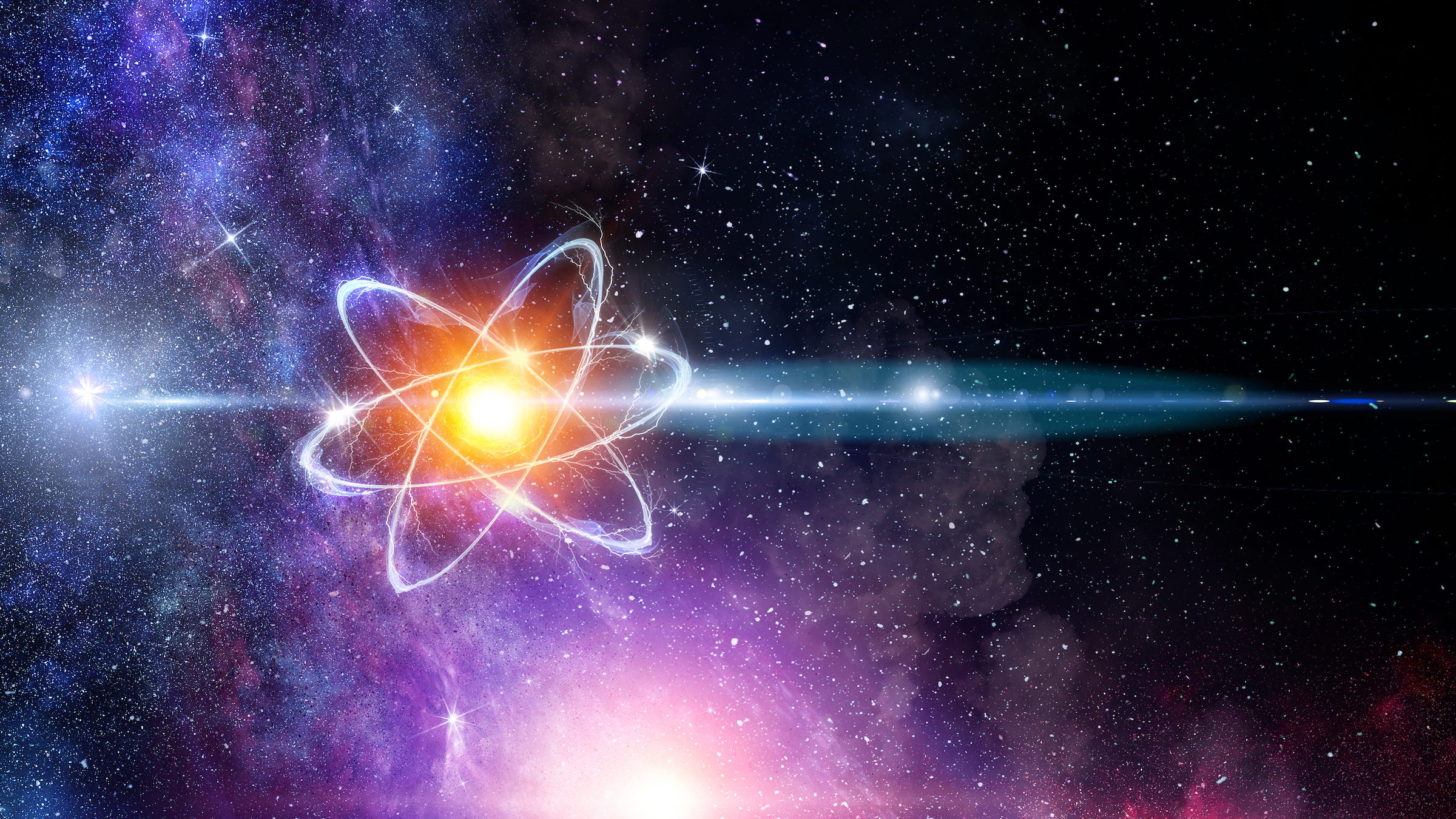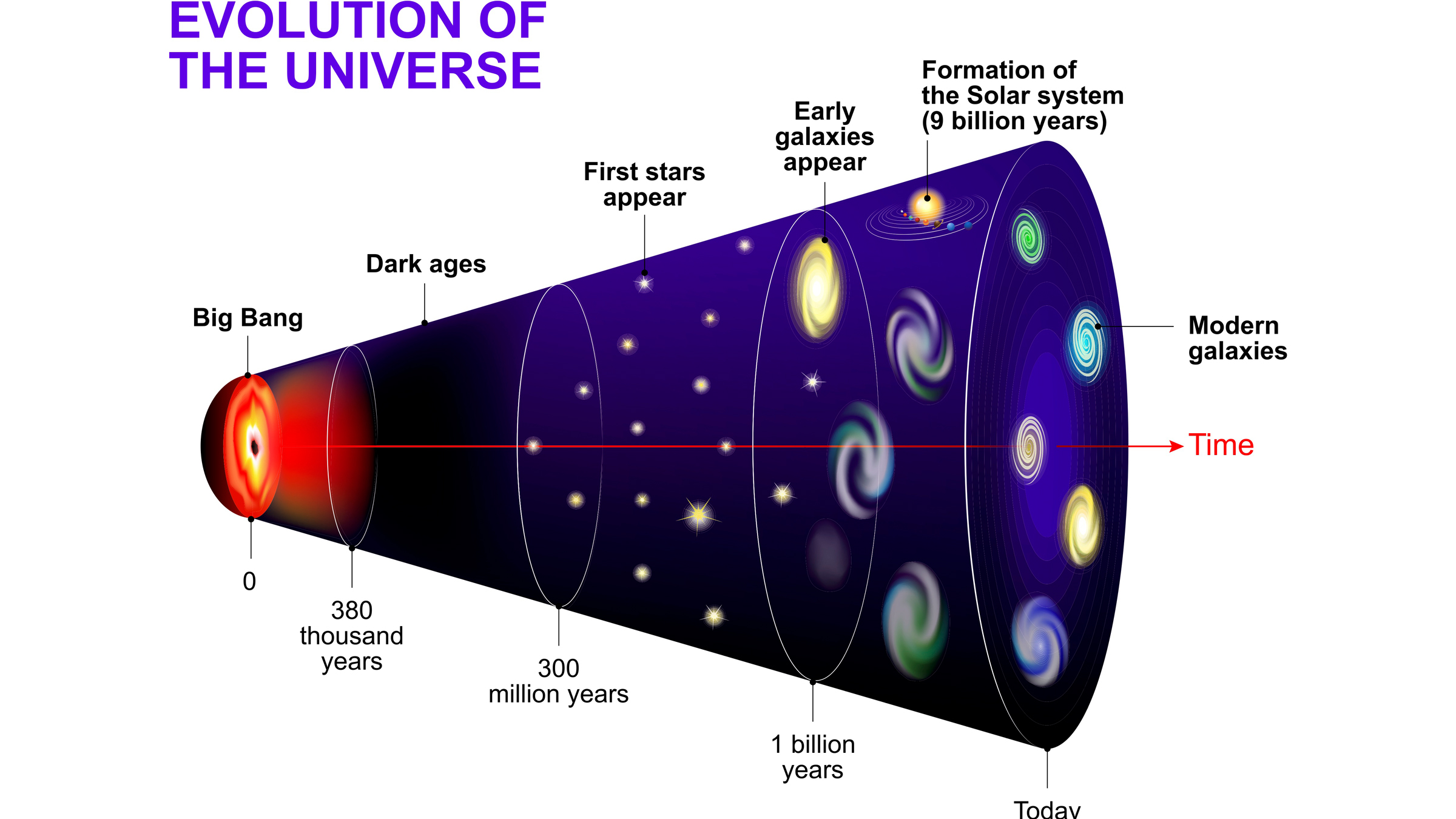How many atoms are in the observable universe?
Luckily, we don't have to count them one by one.

All matter in the universe — no matter how big, small, young or old — is made up of atoms.
Each of these building blocks consists of a positively charged nucleus, made up of protons and neutrons, and negatively charged orbiting electrons. The number of protons, neutrons and electrons an atom has determines which element it belongs to on the periodic table and influences how it reacts with other atoms around it. Everything you see around you is just a configuration of different atoms interacting with one another in unique ways.
So, if everything is made of atoms, do we know how many atoms are in the universe?
Related: Why does outer space look black?
To start out "small," there are around 7 octillion, or 7x10^27 (7 followed by 27 zeros), atoms in an average human body, according to The Guardian. Given this vast sum of atoms in one person alone, you might think it would be impossible to determine how many atoms are in the entire universe. And you'd be right: Because we have no idea how large the entire universe really is, we can't find out how many atoms are within it.
However, it is possible to work out roughly how many atoms are in the observable universe — the part of the universe that we can see and study — using some cosmological assumptions and a bit of math.
The observable universe
The universe was created during the Big Bang 13.8 billion years ago. As it exploded into existence, from a single point of infinite mass and temperature, the universe began expanding outward and hasn't stopped since.
Get the world’s most fascinating discoveries delivered straight to your inbox.
Because the universe is 13.8 billion years old and the observable universe stretches as far away from us as light can travel in the time since the universe was born, you might assume that the observable universe stretches only 13.8 billion light-years in every direction. But because the universe is constantly expanding, this isn't the case. When we observe a distant galaxy or star, what we are really seeing is where it was when it first emitted the light. But by the time the light reaches us, the galaxy or star is much farther away than it was when we saw it. Using cosmic microwave background radiation, we can work out how fast the universe is expanding, and because that rate is constant — which is currently scientists' best guess (although some scientists think it may be slowing down) — that means that the observable universe actually stretches 46 billion light-years in all directions, according to Live Science's sister site Space.com.
But knowing how big the observable universe is doesn't tell us everything we know about how many atoms are in it. We also need to know how much matter, or stuff, is in it.

Cosmic assumptions
Matter is not the only thing in the universe, however. In fact, it makes up only about 5% of the universe, according to NASA. The rest consists of dark energy and dark matter, but because they are not made up of atoms, we don't need to worry about them for this mystery.
Related: What happens in intergalactic space?
According to Einstein's famous E=mc^2 equation, energy and mass, or matter, are interchangeable, so it is possible for matter to be created from or transformed into energy. But on the cosmic scale of the universe, we can assume that the amount of matter created and uncreated cancel each other out. This means matter is finite, so there are the same number of atoms in the observable universe as there always have been, according to Scientific American. This is important because our picture of the observable universe is not a single snapshot in time.
According to our observations of the known universe, the physical laws that govern it are the same everywhere. Combined with the assumption that the expansion of the universe is constant, this means that, on a large scale, matter is uniformly distributed throughout the cosmos — a concept known as the cosmological principle. In other words, there are no regions of the universe that have more matter than others. This idea allows scientists to accurately estimate the number of stars and galaxies in the observable universe, which is useful because most atoms are found within stars.
Simplifying the equation
Knowing the observable universe's size and that matter is equally and finitely distributed across it makes it a lot easier to calculate the number of atoms. However, there are a few more assumptions we have to make before we break out the calculator.
First, we must assume that all atoms are contained within stars, even though they aren't. Unfortunately, we have a much less accurate idea of how many planets, moons and space rocks there are in the observable universe compared with stars, which means it is harder to add them into the equation. But because the vast majority of atoms in the universe are contained within stars, we can get a good approximation of the number of atoms in the universe by figuring out how many atoms there are in stars and ignoring everything else.
Second, we must assume that all atoms in the universe are hydrogen atoms, even though they aren't. Hydrogen atoms account for around 90% of the total atoms in the universe, according to Los Alamos National Laboratory, and an even higher percentage of the atoms in stars, which we are focusing on. As you will see shortly, it also makes the calculations a lot simpler.
Doing the math
Now, it's finally time to do the math.
To work out the number of atoms in the observable universe, we need to know its mass, which means we have to find out how many stars there are. There are around 10^11 to 10^12 galaxies in the observable universe, and each galaxy contains between 10^11 and 10^12 stars, according to the European Space Agency. This gives us somewhere between 10^22 and 10^24 stars. For the purposes of this calculation, we can say that there are 10^23 stars in the observable universe. Of course, this is just a best guess; galaxies can range in size and number of stars, but because we can't count them individually, this will have to do for now.
On average, a star weighs around 2.2x10^32 pounds (10^32 kilograms), according to Science ABC, which means that the mass of the universe is around 2.2x10^55 pounds (10^55 kilograms). Now that we know the mass, or amount of matter, we need to see how many atoms fit into it. On average, each gram of matter has around 10^24 protons, according to Fermilab, a national laboratory for particle physics in Illinois. That means it is the same as the number of hydrogen atoms, because each hydrogen atom has only one proton (hence why we made the earlier assumption about hydrogen atoms).
This gives us 10^82 atoms in the observable universe. To put that into context, that is 10,000,000,000,000,000,000,000,000,000,000,000,000,000,000,000,000,000,000,000,000,000,000,000,000,000,000,000 atoms.
This number is only a rough guess, based on a number of approximations and assumptions. But given our current understanding of the observable universe, it is unlikely to be too far off the mark.
Editor's Note: This article was updated at 12:10 p.m. ET on July 12, 2021 to remove an extra zero from the 10^82 number.
Originally published on Live Science.

Harry is a U.K.-based senior staff writer at Live Science. He studied marine biology at the University of Exeter before training to become a journalist. He covers a wide range of topics including space exploration, planetary science, space weather, climate change, animal behavior and paleontology. His recent work on the solar maximum won "best space submission" at the 2024 Aerospace Media Awards and was shortlisted in the "top scoop" category at the NCTJ Awards for Excellence in 2023. He also writes Live Science's weekly Earth from space series.



